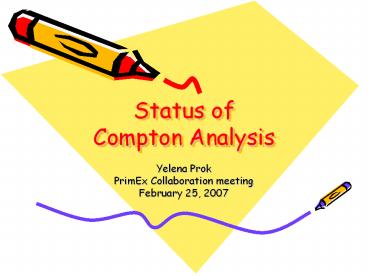Status of Compton Analysis - PowerPoint PPT Presentation
Title:
Status of Compton Analysis
Description:
Study of integrated vs total cross section. Implementation of radiative ... at the Born level for all carbon and beryllium data for 4.9 E 5.5 GeV beam ... – PowerPoint PPT presentation
Number of Views:15
Avg rating:3.0/5.0
Title: Status of Compton Analysis
1
Status of Compton Analysis
- Yelena Prok
- PrimEx Collaboration meeting
- February 25, 2007
2
Outline
- Analysis Note posted before the last meeting no
comments received - -gtit must be perfect
- Since the last meeting
- Study of integrated vs total cross section
- Implementation of radiative corrections, Primex
Note
3
Integrated (Partial) XS
- Data with the beam energy in the range of
4.9ltElt5.5 GeV covers the angular range of
0.2-3.0 degrees (due to our geometry). - When evaluating the total cross section, a large
fraction of the final result comes from the
extrapolation in the rest of the region - Is there any systematic uncertainty introduced by
this extrapolation? - To answer this question we evaluate cross
section, integrated over four regions of the
photons scattering angle - 0.1 lt ?? lt 90
- 0.1 lt ?? lt 10
- 0.1 lt ?? lt 5
- 0.1 lt ?? lt 3
4
Generated kinematics
0.0 lt ?? lt 180
0.1 lt ?? lt 5.0
electron
photon
photon
electron
Scattering angle (deg)
Scattering angle (deg)
5
Efficiency
6
Integrated Cross Section, (Be target)
Experimental result relative to theory is
independent of which region is chosen
7
Born?BornRC
- Cross section evaluation
- Yield, N
- Efficiency, ?
- Theory, ?theory
- ?expt N/?
?theory,born
?expt
In order to evaluate radiative corrections, need
1. Radiated theory ?theory,BORN ? ?theory,
BORNRC 2. Radiated efficiency ?0 ? ?RC
8
Radiative Corrections
- Virtual possibility of emission and
re-absorption of virtual photon by an electron
during the scattering process - Double Compton scattering
- Soft secondary photon of energy kltltkmax, not
accessible to the experiment - Hard secondary photon of energy kgtkmax,
accessible to the experiment
9
Total (RC) Cross Section (1)
- Integrate differential cross sections for 2
processes, soft-virtual and hard double
scattering. - Corrections separated into 2 based on whether the
energy of secondary emitted photon is greater or
smaller than some parameter ?2max ltlt me - Soft-Virtual term, based on ref. 4 of PN 42,
contains a term ln(?2max/me) integrated over
the scattered photons polar angle - Double-hard term, according to ref. 5 of PN
42, ?2max is a lower limit of integration over
the energy of one of the scattered photons
integration is carried also over the 2 polar
angles of the scattered photons, and azimuthal
angle between their planes. - Result must be independent of the choice of ?2max
10
Total correction wrt Born term(independent of
the choice of ?2max )
11
Total (RC) Cross Section
Used 2 independent methods of numeric
integration to check the values of total cross
section and compare with NIST
Uncertainties NIST (5 ) Integration ( 1 )
12
Event Generators
- Utilizing BASES/SPRING package
- created event generators
- for 2-particle and 3-particle processes
- Generated 2-particle and 3-particle events
according to their total cross section ratio - Propagated events through the setup
- using GEANT-3
- Calculated radiated efficiency
13
Generated Kinematics
Born vs BornSV vs Double Compton Scattering
electron
electron
photon
photon
Scattered energy (GeV)
Scattering angle ?(deg)
14
Generated Occupancy on HyCal
Born
BornSV
Double Compton
Y(cm)
X (cm)
Cut 2 particles outside of the central hole
15
Generated Occupancy on Hycal
Born
BornSV
Double Compton
Y(cm)
Y(cm)
Cut 2 particles outside of the central hole
16
Clusters on Calorimeter
Double Compton event
Born SV event
17
Radiated Efficiency
Carbon Target
Born
BornSVDC
Radiated efficiency is 5 smaller (needs more
checks)
18
Radiatively Corrected Cross Section
1 agreement between the data and theory
(more checks are needed)
19
Done
To Do
- Total, integrated, and differential cross
sections are evaluated at the Born level for all
carbon and beryllium data for 4.9ltElt5.5 GeV beam - Mechanism for implementation of radiative
corrections has been developed and is documented
in Primex Note 42 - Initial evaluation of radiatively corrected cross
section with the carbon target shows very good
agreement with theory (1 )
- New flux/binning scheme
- More work on RC (also for the Be target)
- Systematic Errors
- Low energy data set

